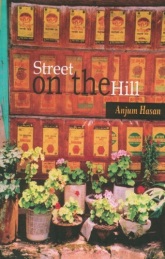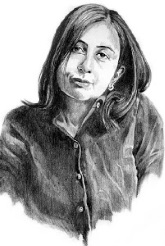Street on the Hill
Anjum Hasan

Paperback:
|
The small town of Shillong, depicted in Anjum Hasan’s poetry collection, Street on the Hill, appears to be a constricting place which limits people’s dreams and aspirations through societal codes of conventions and prescriptive normative ways of behavior. Gaston Bachelard, the twentieth century French philosopher, in Poetics of Space, writes that the congested city is suffocating and does not have many possibilities of affording one a sense of space, and that one must escape into vast, open spaces of wilderness to find freedom and liberation. According to Bachelard, people living in urban cities or in cramped houses, tend to dream of open spaces and wilderness which signify a sense of freedom. This is the hut dream. He argues that it is verticality that gives one a sense of space and enables one to dream. He writes about the importance of attics and cellars, viewing the attic and the stairs ascending to it as a space of clarity, and the descending stairs to the cellar as a descent into irrational fears of the mind. He writes that when apartments are crowded together and there is only horizontality, then they give rise to the hut dream. (3-29, 1958) This paper traces the occurrence of the hut dream throughout Hasan’s poetry. However, contrary to what Bachelard suggests, it seeks to show that Hasan finds spaces of emancipation within the city itself, and need not escape to the woods or the countryside. A few poems suggest that one’s anonymity can offer freedom from expectations, judgments, and set codes of normative social behavior. Hasan’s poems, in which people seem to be longing for the bigger worlds of the cities, suggest that a small town may confine one more than a big city which offers the possibility of liberation through anonymity. In this, she seems to be contradicting Bachelard’s view that only open landscapes can act as spaces of release. Bachelard argues that contemplation of the grandeur of immense tracts of sea and land opens up spaces of freedom and enables dreaming. He uses the term ‘intimate immensity’ to show how the enormity and the sublimity of vast, open spaces such as the forest and the sea can open up room for dreaming and lead us within to intimate corners of ourselves. The poems that follow do not seem to entirely agree with Bachelard’s view. Although they show that a brush with nature leads to a sense of space, they do not seem to suggest that the city necessarily annihilates dreams and that one must go to the countryside in search of space. Instead, we see space as something that can be found within the city itself through the sight of a tree laden with fruit, the darkness of the night, or the wind in the trees. I will now discuss, through the poetry, how the city sometimes tends to confine us, and yet how people are able to find the liberating spaces that they need within the city. The confinement of the city is reflected in Hasan’s ‘June Night in a Middle Class Home’:
The poem explores how the dreams of young girls have been stifled and swallowed by the dull and humdrum life they lead. Their diaries that burn with ‘dread and impatience’ seem to contain unexpressed desires which they know can perhaps never be fulfilled. The kitchen ‘smells mostly of things that are not there’, of whisky, cigarettes and onions in vinegar. Here, she needs to imagine interesting smells in order to compensate for the stale smells that the house actually reeks of. The trunk contains plastic casseroles ‘gathered for an imagined wedding’. Dreams and imagination seem to be the real places where life is lived, by blotting out the drudgery of daily routine which she sees as a kind of death. She writes that the only things in the house that are alive and growing are the buds of the potato and the zinnia. Hasan’s ‘Ordinary Days’ describes everyday life in Shillong, which is apt to get monotonous:
The poem shows us how the spaces within our imagination compensate for whatever is lacking in our ordinary lives. Life in a small town moves slowly, and does not offer much excitement or novelty. She writes that books and maps can show you faraway places, but they cannot make you experience or inhabit them. However, books, wine, and the imagination are the only means by which they can escape the tediousness of the place when they feel that they are ‘growing through the roof of this town’, when they want to stretch their wings beyond limitations that restrict them. ‘Boats’ seems to illustrate Bachelard’s argument that images of boats, ships, rivers and seas are common in city-dreams as one imaginatively escapes.
Here again, our imagination recompenses the sordidness of daily life. Through the creativity and fertility of dreams, inflexible streets are turned into flowing rivers, and unchanging houses into sailing boats. The hut dream tries to find the spaces of freedom which are not actually available in everyday life. In ‘Mister Language’, her need for space and freedom from the constricted small town is again visible:
The poem illustrates her need for something that is missing, a sense of lack which she cannot quite define through language. The poem burning in her throat at age seven which cannot be expressed or written again suggests a stifling atmosphere. She stands at the iron gate of her house, and the purple hill near the street and the football field is all she sees, and the smells of the evening are stale for her. Her dissatisfaction and struggle with the limitations of the town, and of language as well, are evident. To escape from boredom, people derive emotional satisfaction from the food in Chinese restaurants, and dream about big towns where women move around with bright red lipstick, and children play make-believe, pretend games to create an imaginary reality. The small town is seen as constricting, whereas the big cities are seen as liberating, emancipating sites. This is contrary to Bachelard’s valourisation and romanticisation of the countryside as opposed to the city. According to him, it is the immensity and the vastness of the countryside that can liberate us from the confinement and the hut dreams of the city. In ‘To the Chinese Restaurant’, she writes:
They can only dream of people with ‘never-fading lipstick’ and ‘confident gestures’ but they know that they can never actually become like that. The Chinese restaurant acts as a haven from their customary routine: ‘We are plucked from sadness there’. Eating and companionship may also enable one to find liberating spaces. Escape from the confinement and restrictions of the city is found in dreams, imagination, art, and companionship. If the big cities are seen as liberating because of the anonymity they afford, anonymity within the small town is seen as emancipatory as well. This can be seen in ‘Neighbourhood’:
To make love to an anonymous woman, the pakoriwallah needs private space which he can find only through his own anonymity within the public spaces of the city such as the steps leading to someone’s house. This space, temporarily appropriated by the pakoriwallah, serves as a haven for their brief rendezvous, a few moments snatched from a life otherwise freely sprinkled with abuses and kicks in the groin. Green spaces within the city too provide freedom. Hasan does not deem it necessary to go away from the city in order to find emancipation in wilderness. These alternative spaces offer release from an otherwise stifling small town. In ‘November Haiku’, she writes:
Her portrayal of this winter month does not seem drab or dreary, as she shows us vivid images of cherry leaves, oranges, the wind in the roaring buses, and soft nightfall. The tone of this poem seems to be different from the earlier ones which described the stifling atmosphere of the town. In ‘March’ she shows the March wind as a force that has a life of its own:
March is a month of transition, a time when winter is slowly giving way to summer. The March wind, bordoisila, which is shown to be everywhere, in the trees, in graveyards, blowing away newspaper minutes, or with ‘some other fragment of life / pressed to its thin chest’, is a symbol of this change and transformation. This image of energy and bustling activity can be contrasted with the images of monotony and dullness which pervade most of Hasan’s poems. ‘Song of the Fruit’ revels in a delicious orgy of fruits in their wild and growing state. She describes a multiplicity of fruits vividly and sensuously:
She goes on to describe limes, pears, cucumbers, passion fruits, maize, orchids, culminating with the glory of the oranges:
This is because the oranges come in dreary November and add a touch of bright colour to the winter in which most fruits do not survive. Her description of the fruits glows with colour and intensity and can be contrasted with her depiction of the dreary monotony of the town. Hasan seems to be contradicting Bachelard’s theory that a city traps and stifles one and that one must go into the vast spaces of the countryside to dream. The poems discussed above seem to say that spaces of freedom are all around us in the city itself, we do not need to go to rural idylls in search of them. Then, perhaps, the city cannot be seen only as a space of curtailment. These poems show how the drab monotony of a small town stifles one, and yet how the town also offers us spaces of release and escape, through dreams, poetry, imagination, anonymity, and havens of natural beauty. Shruti Sareen | Jul-Aug 2015 | Muse India Read Streets On the Hill Online
|

 Anjum Hasan
Anjum Hasan